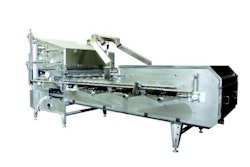
Dr. Hugo A. Medina of Sparboe Farms outlined environmental, managemental and disease factors which influence performance of table egg flocks.
"Producers must balance these complimentary factors including welfare, food safety, flock health and environmental management to produce eggs acceptable to consumers," he stated.
Many factors acting individually or in combination either improve or detract from genetic potential. It is axiomatic that procedures such as cleaning and disinfection, vaccination, implementing biosecurity and routine management incur a cost. Optimal performance can be achieved through allocation of financial and other resources to harmonize the immediate environment of flocks. This includes attention to ventilation, lighting, correct allocation of feed and the supply of cool, potable water.
Dr. Medina stressed the need to control erosive diseases which detract from performance including mycoplasmosis, pasteurellosis, colibacillosis and enteritis. Viral respiratory infections including bronchitis and lentogenic Newcastle disease interact with E. coli and the severity of clinical impact can be influenced by inappropriate ventilation, atmospheric dust and other stress factors.
Dr. Paul Aho: Energy versus protein, the future relative costs of corn, soybean meal and DDGS
Dr. Paul Aho of Poultry Perspectives is a prominent economist dealing with issues relating to the domestic and world's poultry industries.
The outstanding message from his presentation is that the price of grain is linked inexorably to the price of energy. This is illustrated by the spike in both corn and soybean prices during 2008 concurrent with the unprecedented rise in the cost of energy. The mandate established by Congress to divert corn to the production of ethanol for vehicle fuel is a function of the grain to energy relationship.
It is estimated that for the 2008-2009 crop year, 3.6 billion bushels of corn representing 30% of the U.S. corn crop will be used to produce ethanol. The current U.S. biofuels policy is supported artificially by imposing a punitive tariff on the import of sugar-based ethanol from Brazil and extending a subsidy on blending.
Without these advantages, the ethanol industry would not be viable. With the fall in the price of oil from a peak of $140 per barrel to $50 per barrel, many ethanol plants ceased production and many companies and cooperatives have filed for bankruptcy as they are unable to service debts incurred for capital expenditure.
Dr. Aho reviewed the major causes for the decrease in the price of grains over and above the influence of energy. The general worldwide economic downturn, flight of speculators from commodities and increase in grain supplies including wheat from Australia resulted in an easing of prices.
Dr. Aho does not anticipate that the reduction in ingredient costs will carry forward into the future. He anticipates that oil will gradually increase to over $100 per barrel within three years.
Veteran oil man T. Boone Pickens forecasts oil at $75 per barrel by the end of 2009. Based on projections in oil price, Aho sees the current corn crop at $4.20 per bushel with relative stability through the 2009/2010 harvest and a gradual increase thereafter to $5 per bushel. Soybean meal attained $320 per ton in late 2007 with a decline to the current value of $250. This commodity will also show an increase over the proximal two years in sympathy with the price of corn although the corn to soybean ratio of approximately 1:2 has been restored as the world recession recedes and demands increase.
Current low prices are a respite but do not represent a long term trend as both energy and grain prices will increase in response to the law of supply and demand.


















